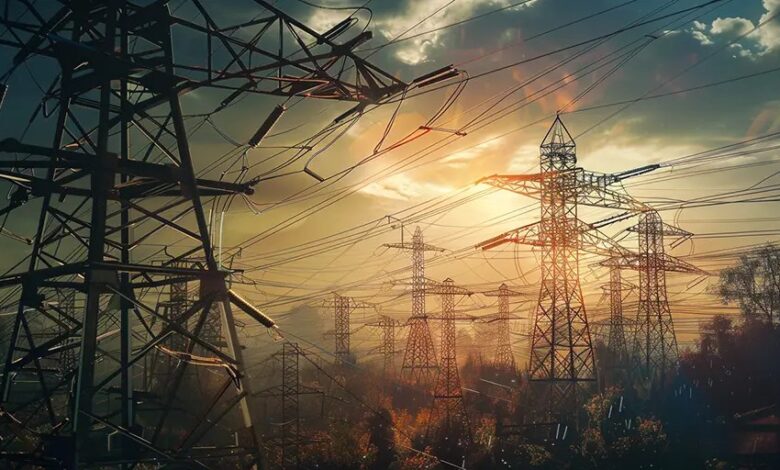Out Of Transmission Revisited – Watts Up With That?

Robert Bryce
The “energy transition” depends on massive expansions of our high-voltage transmission grid. But capacity additions are falling, and per-mile costs and utility product costs are soaring.
Proponents of the much-hyped “energy transition” frequently claim that rapid decarbonization of the electricity sector can only be achieved with huge expansions of America’s high-voltage transmission grid. We are told those expansions, totaling tens of thousands of miles of new capacity, must be completed in the next decade or two.
Once this “grid modernization” has been completed, the new grid will deliver juice from vast areas of rural America that have been paved with solar panels and wind turbines to consumers living in distant cities. In doing so, this new grid will deliver us to the Valhalla of “a net-zero economy with high electrification of transport, industry, and buildings by midcentury,” in which, presumably, everyone is using “clean” energy that’s too cheap to meter.
But there’s a terawatt-size disconnect between the rhetoric and the reality. America isn’t building anything close to the amount of high-voltage transmission capacity that the wind promoters, solar advocates, and spreadsheet jockeys claim is needed. Indeed, the latest numbers from Atlanta-based C Three Group show that the amount of new high-voltage transmission (230kV and above) built annually in the United States is flat or declining. Furthermore, the cost of building new high-voltage capacity and the components needed to expand the electric grid is skyrocketing. Meanwhile, all across rural America, transmission projects are facing fierce resistance from local communities and some Native American tribes. Let’s take a look.
In 2023, the U.S. added about 1,251 miles of new high-voltage capacity. That’s significantly below the average number of miles added to the U.S. power grid over the past two decades. According to C Three, which has the best information on transmission trends in the U.S., about 1,677 miles of new high-voltage capacity was added annually to the grid between 2008 and 2023.
.
As seen in the graphic above, new capacity additions peaked in 2013, when Texas completed the CREZ lines, a system of HV lines spanning some 3,600 miles. That $7 billion project is significant because the CREZ lines were all built intrastate. That is, they didn’t cross any state boundaries, which made the permitting process much easier. In addition, Texas has very little federal land and relatively few state parks.
Costs are also soaring. Before diving into those numbers, reviewing the hype is essential. Last February, in the original “Out Of Transmission” published in these pages, I explained that billionaire investor John Doerr, who has funded a “sustainability” school at Stanford University and is giving hundreds of millions of dollars to climate activist groups, claims we need enormous expansions of the grid to accommodate more wind and solar projects.
In his 2021 book Speed & Scale: An Action Plan for Solving Our Climate Crisis Now, Doerr lays out what he calls “Key Emission Reduction Policies” including a clean electricity standard that could, in theory anyway, cut emissions by at least 50% by 2025 and 100% by 2040. In what amounts to a footnote, Doerr explains that his modeling assumes “a doubling of the transmission system above business as usual.” But Doerr didn’t deign to explain how that doubling will happen.
In that same article, I explained that in 2022, the Biden administration announced a $2.5 billion fund to help bankroll the buildout of the nation’s high-voltage transmission system. I cited a May 10, 2022, press release from the Department of Energy which said:
Independent estimates indicate that we need to expand electricity transmission systems by 60% by 2030, and may need to triple it by 2050 to meet the country’s increase in renewable generation and expanding electrification needs.”
Also, in February 2023, the Department of Energy released the “National Transmission Needs Study,” which claims the U.S. needs to build 47,300 gigawatt-miles of new power lines by 2035. The study didn’t define gigawatt-miles. But it did say that “in future scenarios with moderate load but high clean energy assumptions,” the U.S. will need “a 57% growth in today’s transmission system.” Given that the current grid has about 240,000 miles of high-voltage capacity, that would require building roughly 136,000 miles of new capacity. The same report says, “By 2040, new transmission deployment is projected between 100,000 and 185,000 GW-mi (115,000 GW-mi median), a doubling in size of today’s transmission system.”
Last November, Jesse Jenkins, who heads the Zero Lab at Princeton University, told Utility Dive that “By 2035 alone we’re going to need to add about 75,000 miles of high voltage transmission lines, enough to run from New York City to Los Angeles and back 15 times…That sounds like a lot for a country not used to building big things. But we have built big things in the past, this is not unprecedented, and shouldn’t be viewed as impossible.”
Jenkins may be correct that it “shouldn’t be viewed as impossible.” But the odds of the U.S. building 75,000 miles of new high-voltage transmission over the next 10 years are, as my father used to say, “slim and none, and Slim left town.”
The math here is so simple even a Ph.D. could do it. Jenkins claims the U.S. must build 75,000 miles of transmission in 10 years, or 7,500 miles per year. But there’s no precedent — none — for adding that much capacity. Indeed, constructing that much new transmission would require a four-fold increase in the average number of line miles built annually since 2008. Furthermore, that pace of new capacity would have to be sustained for a decade.
The hard truth about the alt-energy/net-zero/energy transition hype is that almost no one — including Doerr, DOE, Jenkins, reporters at big media outlets, pundits, and others — has bothered to do the math. They did not calculate how much transmission we are building every year or how long it may take to achieve significant expansions of the power grid. In other words, it’s easy to talk about adding transmission capacity. But building high-power lines is hard. Really hard. And the cost of building them is soaring.
.
According to C Three, recently acquired by Yes Energy, each mile of new high-voltage capacity added to the grid in 2023 cost about $3.95 million. As seen in the figure above, that’s nearly triple the per-mile cost recorded in 2008. During a recent phone interview, C Three’s president and founder, Jean Reaves Rollins, told me that “a big chunk” of the surge in costs “is due to the soaring cost of acquiring right of way and dealing with permits and regulatory compliance.” Rollins, who has worked in the utility sector for decades, said building any high-power infrastructure is challenging. For instance, installing a 345kV substation, she said, can take three to five years. It requires experienced linemen, engineers, and lots of heavy equipment. “These big infrastructure projects don’t happen quickly. The grid is enormously complex,” she said. “It requires hundreds of suppliers and a lot of complicated engineering, not to mention acquiring rights of way.”
Rollins is doubtful that significant quantities of new greenfield transmission will be built in the next few years. “About the only way to add new capacity today is to upgrade the existing high-voltage transmission line you have,” she said.
In addition to the cost and difficulty of acquiring rights of way, electric utilities across the country are seeing staggering cost increases in the products they need to maintain and upgrade the grid. Matt Brandrup, the CEO of the Wisconsin-based Rural Electric Supply Cooperative, recently sent me the latest information on price increases for commodities like conductor and transformers.
Brandrup, who was on the Power Hungry Podcast last March, told me that “RESCO’s 2023 average electric utility product cost inflation rate on the distribution and transmission products we sell (transformers, underground/overhead conductor, related hardware, poles, etc) finished at just over 10%.” He noted that over the past three years, “Transformers (single-phase transformers that feed the homes and small business and the larger three-phase transformers that feed the larger businesses and industrial type of loads) have all increased by 50 to 75% depending upon the manufacturer.” He continued, noting that the cost of primary underground conductor, the wire used in main underground circuits, has jumped by 50%, and the cost of overhead conductor (the wire used to feed pole-mounted transformers) has increased by 45%.
.
As seen above, utility product costs have climbed steadily since 2017. Brandrup broke down the impact of this inflation on electric coops and other electricity providers. “A $10,000,000 work plan budget (total cost of materials purchased by that member) in 2020 would now cost our member $14,800,000 in 2024 if they purchased the same exact material,” he said.
In addition to the construction and cost issues, transmission projects are being hindered by local opposition. In my May 26, 2023 piece, “47,300 Gigawatt-Miles From Nowhere,” I wrote about the 345 kV Cardinal-Hickory Creek transmission project that aims to move juice from Iowa to Wisconsin. That 102-mile project, which initiated public involvement in 2014, is now 98% complete. But it has been delayed by multiple legal challenges and is expected to cost $500 million, or roughly $5 million per mile, far more than the $3.9 million figure I cited above. The project includes 1.3 miles of wire that cross the Mississippi National Wildlife and Fish Refuge. In 2021, several conservation groups sued to stop the project. A lawyer for the plaintiffs explained the litigation is “really an effort to preserve our public conservation lands from encroachment from massive transmission lines and pipelines.”
In October, in an embarrassing move, the Bureau of Land Management rescinded approval of the Rock Creek Wind Gen-Tie transmission line in southeast Wyoming after the Albany County Conservancy sued it. As reported in Cowboy State Daily, the line:
Was proposed to connect the Rock Creek Wind project to two larger transmission lines that will carry wind energy out of Wyoming. The lawsuit claimed the approval process was improperly done, without required public notification and without opportunities for public participation, including public comments. All of that is required as part of the National Environmental Policy Act.
Last month, the San Carlos Apache tribe, Tohono O’odham Nation, the Center for Biological Diversity, and Tucson-based Archaelogy Southwest sued to stop the construction of a $10 billion high-voltage transmission project that aims to connect a wind project in New Mexico to consumers in southern Arizona. The groups filed suit in federal court alleging that the U.S. Bureau of Land Management failed to comply with federal statutes when it approved the 500-kV SunZia Southwest Transmission Project. The 32-page complaint alleges the $8 billion project will cause “serious, irreversible adverse effects on Tribal cultural sites and sacred areas, including areas with human remains.” They are seeking a restraining order or injunction to stop the project and require federal agencies to adhere to the provisions of the National Historic Preservation Act and Administrative Procedures Act.
On February 6, two Minnesota counties — Meeker and Chippewa — adopted one-year moratoriums on wind and solar projects because local regulators were concerned that the projects would result in the construction of transmission lines across their counties.
There’s also widespread opposition on the East Coast to the proposed transmission projects needed to bring power ashore from offshore wind projects.
I could cite many more examples of the opposition to transmission here. But the punchline here is obvious: the high-voltage grid is expanding very slowly, the costs associated with it are soaring, and the opposition to such a vast expansion is real and growing.
These facts indicate that the “energy transition” to a grid mainly powered by far-flung wind and solar projects will not happen. That means we must use the existing rights of way and wires to the fullest extent possible. I will close by repeating what I wrote last year in “47,300 Gigawatt-Miles From Nowhere.” I explained we won’t see a quick expansion of the high-voltage grid:
Because of the physical limits on the system. Given these limits, policymakers aiming to decarbonize the electric sector should be looking at ways to utilize existing infrastructure, including wires and transformers, by building new nuclear plants on the sites where coal- or gas-fired power plants are being retired. That’s what TerraPower hopes to do in Kemmerer, Wyoming and other locations. In short, the electric grid we have today is largely the electric grid we are going to have. We should not be spending hundreds of billions of dollars to build a grid designed to accommodate the low power density of weather-dependent renewables like wind and solar. Instead, we should be building high-power-density, weather-resilient generation that can exploit our existing grid. That, of course, means nuclear energy.
What I wrote last May still applies today. If we are serious about reducing CO2 emissions from the electric sector, that means building lots and lots of nuclear reactors. Building lots of new nuclear won’t be cheap, quick, or easy. But it will be far more manageable (and probably more affordable) than trying to string tens of thousands of miles of new transmission lines across the American West.




